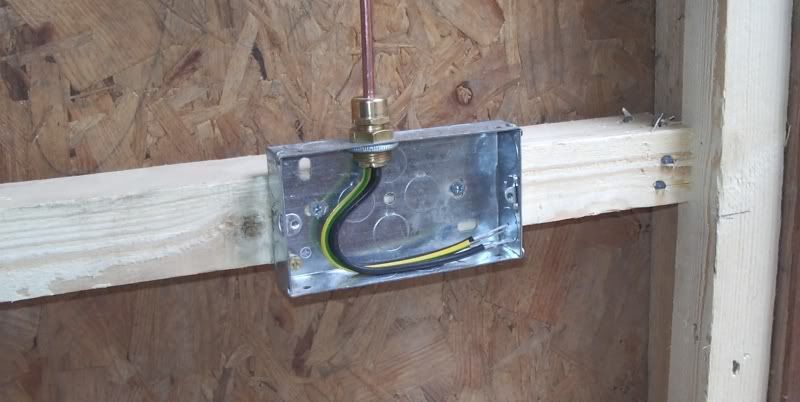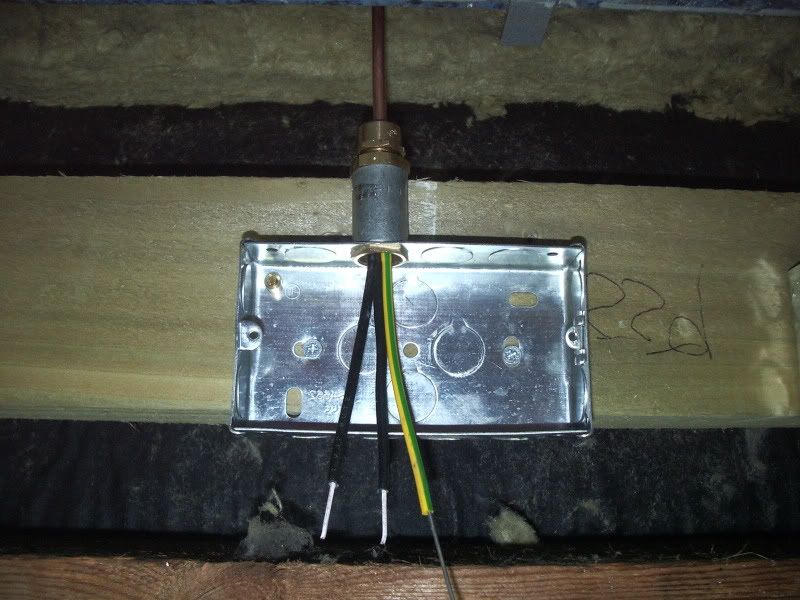Having taken on board the advice here I am now going to use pyro for the lighting circuits in the loft area. This will increase the cost and time involved but will be the best method in the long term.
You are using an out of date browser. It may not display this or other websites correctly.
You should upgrade or use an alternative browser.
You should upgrade or use an alternative browser.
Singles in conduit. Domestic
- Thread starter bernardgreen
- Start date
As a matter of interest (I've never used pyro), how does one deal with the terminations in a domestic lighting circuit (switches, light fittings etc.) when wiring is in pyro? Does one have to use JBs of some sort to convert to T&E, or does one attempt to terminate the pyro in the fittings/accessories?Having taken on board the advice here I am now going to use pyro for the lighting circuits in the loft area. This will increase the cost and time involved but will be the best method in the long term.
Kind Regards,John.
pyro to the fittings..
terminated into couplers on the backboxes so that the end of the gland does not protrude into the box..
terminated into couplers on the backboxes so that the end of the gland does not protrude into the box..
Ah, I see - thanks. That presumably means that one needs to create a reasonable sized hole adjacent to the backbox (if it's in plaster/masonry)?pyro to the fittings..
terminated into couplers on the backboxes so that the end of the gland does not protrude into the box..
Kind Regards, John.
Had a conversation with the applications department of one of the manufactures of mineral insulated cable and all my questions have been answered.
The termination to ceiling roses is not as complicated as it seems. Provided the cable is clamped to prevent movement a screw on pot with earth lead inside a metal enclosure is sufficient in those applications where the installation does not have to survive a fire
The termination to ceiling roses is not as complicated as it seems. Provided the cable is clamped to prevent movement a screw on pot with earth lead inside a metal enclosure is sufficient in those applications where the installation does not have to survive a fire
- Joined
- 26 Jul 2010
- Messages
- 223
- Reaction score
- 25
- Country

Your insurance company and/or Local Authority may have additional requirements where thatched properties are concerned they often specify fire resistant containment and sometimes void smoke detection.
The majority of modern thatches are ammonia treated as to be flame retardent and many now are seed-free so rodent damage is not so relevant as it was in the past, though I would still take the attack of fauna into consideration.
The majority of modern thatches are ammonia treated as to be flame retardent and many now are seed-free so rodent damage is not so relevant as it was in the past, though I would still take the attack of fauna into consideration.
Why is that needed?pyro to the fittings..
terminated into couplers on the backboxes so that the end of the gland does not protrude into the box..
H
holmslaw
..
Why is that needed?pyro to the fittings..
terminated into couplers on the backboxes so that the end of the gland does not protrude into the box..
1) Space.
2) The wires from the gland will not be strained or bent at right angles out of the pot. They will travel straight away from the pot down the coupler.
Can you get brass couplers?
Not that I've ever seen.
Here's the difference between using a coupler or not.

With

Without
It's amazing what's in my archives!!
Here's the difference between using a coupler or not.

With

Without
It's amazing what's in my archives!!
Can you get brass couplers?
I've never seen such an item, and initial thoughts are that brass would be too soft a metal and it would 'bell out' too easily when tightened, also would be expensive
I suppose if you really wanted brass you could try and machine one up yourself, probably have to make it quite a bit thicker than standard couplers or it would just break!
How about having a coupler electro-plated?
The termination to ceiling roses is not as complicated as it seems. Provided the cable is clamped to prevent movement a screw on pot with earth lead inside a metal enclosure is sufficient in those applications where the installation does not have to survive a fire
Bernard,
I'd recommend you use an appropiate BESA box in the attic to suit number ans direction of cables... if looking in and out these are likely to be trouser or tee boxes you'll need for most, fitted to a batten fixed between two joints, then use an extension ring to extend the box to flush with the ceiling
Can you still get flush MI BESA boxes? I've had a quick google with no joy.
The "joists" are very old round timbers just large enough to support the original lath and plaster ceiling. It is un-likely the joists will safely support the weight of a person. So work above the ceiling has to be limited to that which does not require a person being there. Conservation means the absolute minimum of disturbance of the ceiling.fitted to a batten fixed between two joints,
This was the reason for using conduit which could be manipulated from the access hatch in the next room until its end was close enough to the hole in the ceiling to enable the cable to be fished for through the hole and then guide the 90 degree bend at the end of the conduit through the hole.
DIYnot Local
Staff member
If you need to find a tradesperson to get your job done, please try our local search below, or if you are doing it yourself you can find suppliers local to you.
Select the supplier or trade you require, enter your location to begin your search.
Please select a service and enter a location to continue...
Are you a trade or supplier? You can create your listing free at DIYnot Local
Similar threads
- Replies
- 41
- Views
- 27K
- Replies
- 4
- Views
- 9K
